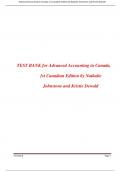Exam (elaborations)
TEST BANK for Advanced Accounting in Canada, 1st Canadian Edition by Nathalie Johnstone and Kristie Dewald and Cheryl Wilson. ISBN-13: 9780135653906 A+
- Course
- Institution
- Book
TEST BANK for Advanced Accounting in Canada, 1st Canadian Edition by Nathalie Johnstone and Kristie Dewald and Cheryl Wilson. ISBN-13: 9780135653906 A+ TABLE OF CONTENTS Chapter 1 Introduction to Advanced Financial Ac counting Page : 9 Chapter 2 Accounting for Non-Controlled Investments Page : 50 C...
[Show more]



